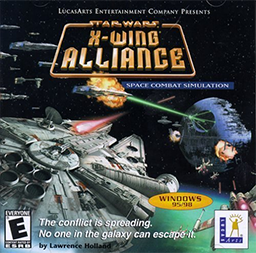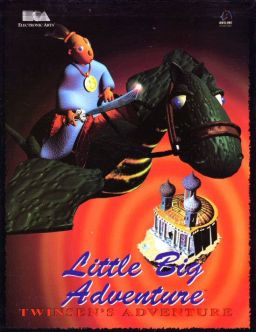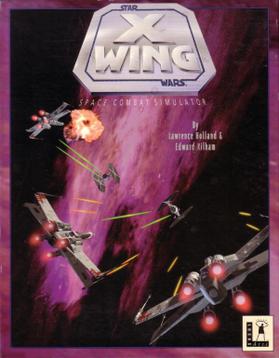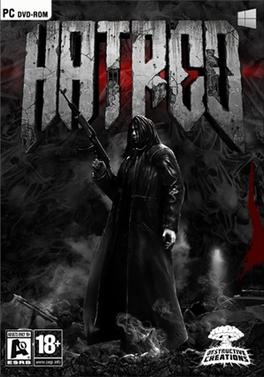
Star Wars: X-Wing Alliance is a space simulation video game, the sequel to both Star Wars: TIE Fighter and Star Wars: X-Wing vs. TIE Fighter. X-Wing Alliance presents the story of the Azzameen family, a family of space traders. The player assumes the role of Ace Azzameen, the youngest of the Azzameen children, juggling military duty as a fighter pilot for the Rebel Alliance, and allegiance to his family, flying larger heavily armed freighters for the family business, amid a bloody family feud and in the larger context of a galactic civil war. It received favorable reviews.

Wasteland is a role-playing video game developed by Interplay Productions and published by Electronic Arts in 1988. The first installment of the Wasteland series, it is set in a futuristic, post-apocalyptic America destroyed by a nuclear holocaust generations before. Developers originally made the game for the Apple II and it was ported to the Commodore 64 and MS-DOS. It was re-released for Microsoft Windows, OS X, and Linux in 2013 via Steam and GOG.com, and in 2014 via Desura. A remastered version titled Wasteland Remastered was released on February 25, 2020, in honor of the original game's 30th anniversary.

Septerra Core: Legacy of the Creator is a role-playing video game developed by Valkyrie Studios and published by Monolith Productions. It was originally released in 1999 for Windows; since then, it has been re-released via GOG.com for Windows in 2009, for OS X in 2013, and for Linux in 2017.

Little Big Adventure is a 1994 action-adventure game developed by Adeline Software International. It was published in Europe by Electronic Arts, and by Activision in North America, Asia and Oceania under the name Relentless: Twinsen's Adventure. Over 500,000 copies were sold by 1999. The game was initially released on CD-ROM and some time later on floppy disks; the CD-ROM version features full-motion video, music and speech whereas the floppy disk version has MIDI music files and still images to replace the videos. The game was later ported to the PC-98 and FM Towns and was released in Japan in 1995. It was released for the PlayStation in Japan and Europe in 1996 and 1997 respectively, and to Android and iOS devices in 2014.

Bad Mojo is an adventure video game by Pulse Entertainment, released in 1996. The player is cast as Roger Samms, an entomologist planning to embezzle money from a research grant to escape his sordid life above an abandoned bar. An accident with his mother's enchanted locket unleashes a curse — the titular bad mojo — that turns him into a cockroach. The storyline in Bad Mojo is loosely based on Franz Kafka's 1915 novella The Metamorphosis; Roger Samms' name is an imperfect anagram of the lead character's in Metamorphosis, and a cat called Franz appears in the game. The gameplay consists of guiding the cockroach through a series of puzzles.
Geoff Crammond is a computer game designer and programmer who specialises in motor racing games. A former defence industry systems engineer, he claims to have had little interest in motor racing before programming his first racing game (Revs) back in 1984, but he holds a physics degree, which may explain the realism of some of his programming. As a consequence of that project he became a big fan of Formula One motor racing. At the end of the 80s, this interest, plus the ever improving capabilities of home computers, inspired him to specialise in programming Formula One racing simulations.

Postal is a 1997 isometric top-down shooter video game developed by Running with Scissors and published by Ripcord Games. Players assume the role of the Postal Dude, a man who goes on a killing spree throughout the fictional town of Paradise, Arizona to cure what he believes to be a "hate plague" released by the United States Air Force.

Jazz Jackrabbit 2 is a 1998 platform game produced by Epic MegaGames. It was released for Windows, and later for Macintosh. Like the first game, Jazz Jackrabbit, Jazz Jackrabbit 2 is a side-scrolling platform game but features additional multiplayer options, including the ability to play over a LAN or the Internet. The game was re-released on GOG.com along with the first game on November 30, 2017.

Brothers in Arms: Road to Hill 30 is a first-person shooter video game developed by Gearbox Software and published by Ubisoft for Xbox, Microsoft Windows and PlayStation 2. It is the first game in the Brothers in Arms series. The game takes place during World War II and focuses on tactics. It was ported to the Wii in 2008, as part of the Brothers in Arms: Double Time compilation.

The 11th Hour is a 1995 interactive movie puzzle adventure game with a horror setting. It is the sequel to the 1993 game The 7th Guest. A 3DO Interactive Multiplayer version was planned but never released.

Star Wars: X-Wing is a space simulation video game, the first of the X-Wing combat flight simulation games series. The player's character flies starfighters, including the X-wing, for the Rebel Alliance. The narrative precedes and parallels the events of Star Wars Episode IV: A New Hope.

CSI: Miami is a 2004 adventure video game based on the CSI: Miami television series. The game was developed by Radical Entertainment, published by Ubisoft, and was released for the Microsoft Windows on April 24, 2004. In 2008, Gameloft redeveloped the game for iOS.

Crusader: No Regret is an isometric action game developed by Origin Systems and published by Electronic Arts in 1996. Nominally a sequel to 1995's Crusader: No Remorse, it is considered both by critics and by the game director more akin to a stand-alone expansion pack. Mechanically similar to No Remorse, it features new levels, enemies and weapons.

F.E.A.R. Perseus Mandate is the second standalone expansion pack for the first-person shooter psychological horror video game F.E.A.R. First Encounter Assault Recon. Developed by TimeGate Studios and originally published by Vivendi Games under the Sierra Entertainment label, it was released for Windows and Xbox 360 in November 2007. The Xbox version was only available packaged with the first expansion, F.E.A.R. Extraction Point, and released as F.E.A.R. Files. On the PC, as well as a standalone release, Perseus Mandate was also bundled with the original game and Extraction Point for F.E.A.R. Platinum Collection, which was also released on Steam in 2012 and GOG.com in 2015. In 2021, F.E.A.R. Files was added to Microsoft's backward compatibility program, making the games playable on the Xbox One and Xbox Series X/S. Neither expansion is now considered canon, as the Monolith Productions-developed F.E.A.R. 2: Project Origin ignores the events of both.

Transformers: Revenge of the Fallen is a third-person shooter video game based on the 2009 live action film Transformers: Revenge of the Fallen. It is the sequel to 2007's Transformers: The Game, and the second video game adaptation of the live-action Transformers film series. The PlayStation 3 and Xbox 360 versions of the game were developed by Luxoflux, and ported to Microsoft Windows by Beenox. The PlayStation 2 and Wii versions were developed by Krome Studios, and the PlayStation Portable version was developed by Savage Entertainment. All versions of the game were published by Activision, and released on June 23, 2009 in the United States. Australia received the games one day later, and Europe on June 26. A sequel, Transformers: Dark of the Moon, was released in June 2011, based on the film on the same name.

NAM, sold under the name Napalm in Walmart retail outlets, is a first-person shooter set during the Vietnam War. It was developed for MS-DOS by TNT Team and published by GT Interactive in 1998. A direct sequel, World War II GI, was released in 1999.

The Witcher 2: Assassins of Kings is a 2011 action role-playing video game developed by CD Projekt Red, based on The Witcher series of fantasy novels by Andrzej Sapkowski. It is the sequel to the 2007 game The Witcher and the second main installment in The Witcher's video game series. It was released for Microsoft Windows, Xbox 360, OS X, and Linux.

Euro Truck Simulator 2 is a truck simulator game developed and published by SCS Software for Microsoft Windows, Linux, and macOS and was initially released as open development on 18 October 2012. The game is a direct sequel to the 2008 game Euro Truck Simulator and it is the fourth video game in the Truck Simulator series.

Omerta – City of Gangsters is a simulation game with turn-based tactical game-play elements developed by Haemimont Games and published by Kalypso Media for Microsoft Windows, Mac OS X and the Xbox 360. The game was released in German-speaking countries on 31 January 2013. The international German download version for Windows was released through the Steam-service as well. The English version was released just a day after in the rest of Europe, and in Australia on 7 February for the PC version, whereas the version for the US market was released on 12 February, followed by the release of the Xbox 360 version in Australia the day after. A version for Mac OS X was published on 2 August 2013.

Hatred is an isometric shoot 'em up video game developed and published by Destructive Creations that was released on June 1, 2015, for Microsoft Windows. The player character is a misanthropic mass-killer referred to as "The Antagonist", who begins a "genocide crusade" to kill as many human beings as possible. The developer described Hatred as a reaction to video game aesthetic trends such as political correctness, politeness, vivid color, and games as art. Its October 2014 announcement trailer was characterized as "controversial" by multiple video game journalists. The game was shortly removed by Valve from their Steam Greenlight service due to its extremely violent content but was later brought back with a personal apology from Gabe Newell. It was greenlit for a second time on December 29, 2014, and released on June 1, 2015.


















